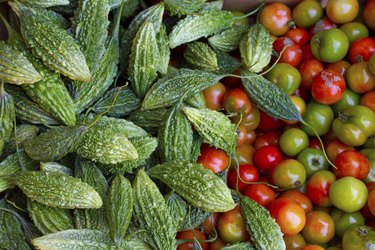
The most heavily populated islands in the Hawaiian chain offer a diverse array of gardening conditions. The Big Island alone is host to five microclimates, from rain forest to desert. A great variety of vegetables will grow in the rich, volcanic soil of the 50th state. Like any region, however, it's best to plant the seeds of varieties that are known to be adapted to the area. Fortunately for the islands' gardeners, the University of Hawaii tests and recommends certain vegetable seeds.
Cucumbers and Pumpkins
Video of the Day
The University of Hawaii has test-grown both a bush hybrid cucumber (Cucumis sativus "Milo") and a vining cucumber (Cucumis sativus "Lani"). Both were bred to be resistant to the cucumber mosaic virus and tolerant to the watermelon mosaic virus and powdery mildew. Because cultivars of Cucurbita moschata, including butternut squash and pumpkins, tolerate humidity, they do well in Hawaii. If you live up mauka and want to grow Halloween pumpkins, choose Curcurbita maxima seeds as they tolerate cold evening temperatures better than other species. These vegetables grow best in lowland tropical conditions.
Video of the Day
Beans and Peas
"Poamoho" stringless pole beans (Phaseolus vulgaris "Poamoho") are the product of a lengthy breeding effort at the University of Hawaii. Crop studies from test farms around the state in the 1970s show that "Poamoho" produces earlier and outyields both the "Hawaiian Wonder" (Phaseolus vulgaris "Hawaiian Wonder") and "Manoa Wonder" (Phaseolus vulgaris "Manoa Wonder") hybrids. The pods are long and slender, which is favored in Hawaii. "Kahala" soy beans (Glycene max "Kahala") and "Manoa Sugar" Chinese peas (Pisum sativum var. saccharatum "Manoa Sugar"), both developed by the University of Hawaii, are two well-adapted alternatives to green beans.
Tomatoes and Eggplant
Tomatoes (Solanum lycopersicum), hardy in U.S. Department of Agriculture plant hardiness zones 2 through 10, grow year-round in Hawaii, and the university has developed several hybrids and varieties that are resistant to common diseases in the state. Tomatoes are heavy water users in most locations in Hawaii, requiring a deep soaking two to three times a week after fruit set. Eggplant, hardy in USDA zones 4 through 10, does well in home gardens in Hawaii. "Waimanalo" long (Solanum melongena var. esculentum "Waimanalo Long") produces the long, slender eggplants popular in the Asian communities in Hawaii.
Cabbage and Cauliflower
Two cole crops that are well-adapted to growing in the islands are cabbage and cauliflower, both Brassica oleracea varieties. Consider growing "Puakea" cauliflower (Brassica oleracea var. botrytis "Puakea"), developed by the University of Hawaii, if you live at elevations below 1,000 feet. "Snow King" (Brassica oleracea var. botrytis "Snow King") and "Snow Queen" (Brassica oleracea var. botrytis "Snow Queen") are better suited for gardens at elevations between 1,000 and 2,500 feet. Mauka gardeners will have the best success growing Super Snowball (Brassica oleracea var. botrytis "Super Snowball"). Agriculturists with the University of Hawaii recommend the "Waianae" strain if you grow kai choy, a Chinese mustard cabbage (Brassica juncea). Although it tolerates heat well, kai choy requires consistently moist soil, so you'll need to water frequently in the dryer regions in Hawaii.
- Hathi Trust Digital Library: Mauna Loa Observatory : A 20th Anniversary Report
- University of Hawaii: Pumpkin and Squash
- University of Hawaii: "Poamoho" Pole Bean
- University of Hawaii: Tomato
- EurekaMag.com: Hypocotyl Orientation and Hormone Influence in Vitro Regeneration of Root and Shoot of Cauliflower Brassica Oleracea var Botrytis Puakea
- University of Hawaii at Manoa: Kai Choy
- University of Hawaii at Manoa: Agricultural Diagnostic Service Center - Seed Program
- The Old Farmer's Almanac: Eggplant
- The Old Farmer's Almanac: Tomatoes